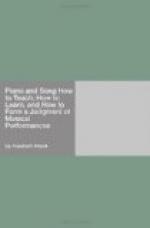I told you that the sounds this way (I strike the keys upward) grow higher, and this way (I strike them downwards) they grow lower. So you see no tones are just alike: one is either higher or lower than the other. Do you hear the difference? Now turn round so as not to see the keys; I will strike two keys, one after the other; now which is the highest (the sharpest), the first or the second? (I go on in this way, gradually touching keys nearer and nearer together; sometimes, in order to puzzle her and to excite close attention, I strike the lower one gently and the higher one stronger, and keep on sounding them, lower and lower towards the bass, according to the capacity of the pupil.) I suppose you find it a little tiresome to listen so closely; but a delicate, quick ear is necessary for piano-playing, and by and by it will become easier to you. But I won’t tire you with it any more now, we will go on to something else. Can you count 3,—1, 2, 3?
BESSIE. Yes, indeed, and more too.
DOMINIE. We’ll see; now keep counting 1, 2, 3, 1, 2, 3, as evenly and regularly as you can. (I lead her to count steadily, and strike at the same time a chord in three even quarter-notes.) Now we’ll see if you can count evenly by yourself. (I count 1 of the chord with her, and leave her to count 2 and 3 by herself; or else I count with her at 2, and let her count 1 and 3 alone; but I am careful to strike the chord promptly and with precision. Afterwards I strike the chord in eighth-notes, and let her count 1, 2, 3; in short, I give the chord in various ways, in order to teach her steadiness in counting, and to confine her attention. In the same way I teach her to count 1, 2, 1, 2; or 1, 2, 3, 4, 5, 6; at the same time telling her that music is sometimes counted in triple time, and sometimes in 2/4 or 4/4 time.) Now, Bessie, you have learned to count very well, and to know the difference in the tones. It is not every child that learns this in the first lesson. If you don’t get tired of it, you will some time learn to be a good player. As soon as you are rested, I will tell you about something else, that you will have to listen to very carefully.
BESSIE. But I like it, and will take pains to listen just as closely as I can.
DOMINIE. When several tones are struck at the same time, if they sound well together, they make what we call a chord. But there are both major and minor chords: the major chord sounds joyous, gay; the minor, sad, dull, as you would say; the former laugh, the latter weep. Now take notice whether I am right. (I strike the chord of C major; then, after a short pause, that of C minor; and try, by a stronger or lighter touch, to make her listen first to the major and then to the minor chords. She usually distinguishes correctly; but it will not do to dwell too long upon these at first, or to try to enforce any thing by too much talk and explanation.) Now I will tell you that the difference in the sounds of




